Sweet William Catchfly (Silene armeria) is an annual plant known for its striking deep pink flowers, gathered in impressive clusters. Reaching a height of 30-40 cm, it is an excellent choice for borders, edging, and rock gardens. Its elegant appearance makes it equally suitable as a cut flower, bringing a fresh touch of nature indoors. The upright and branched stems create an eye-catching display from June to August, captivating attention in any garden.
Sowing
Sweet William Catchfly seeds can be sown directly into the ground, but sowing under cover is also possible. The choice of method depends on the gardener's preference and climatic conditions. These seeds are easy to grow, making Sweet William Catchfly ideal for novice garden enthusiasts.
Sowing Depth
The optimal sowing depth for Sweet William Catchfly seeds is approximately 0.5 cm. This depth facilitates quick germination and healthy plant growth, providing the right conditions for development.
Direct Sowing Period
When is the best time to sow Sweet William Catchfly seeds directly into the ground? The optimal period is from April to May, when the soil is warm enough to encourage rapid seed germination.
Sowing Period Under Cover
When to sow Sweet William Catchfly seeds under cover? March is ideal. Early sowing under cover allows for strong and healthy seedlings, ready for transplanting to their permanent location at the appropriate time.
Planting Time
The best period for planting Sweet William Catchfly is from April to June. It is essential to remember that young plants need the right conditions to acclimatise to their new location.
Plant Spacing
When planting Sweet William Catchfly, maintain a spacing of 20x30 cm. Such intervals provide plants with the space needed for growth and development, allowing them to branch freely.
Companion Planting
Sweet William Catchfly pairs well with other annuals, such as marigolds or calendulas. Together, they create harmonious compositions that catch the eye and add charm to any garden.
Site Conditions
Sweet William Catchfly thrives best in sunny locations, where it can fully display its decorative qualities. The soil should be well-drained and moderately moist. Although the plant adapts well to various conditions, it prefers neutral to slightly alkaline soils.
Growing Tips
Sweet William Catchfly is low-maintenance, making it ideal for beginner gardeners. It requires regular watering, especially during dry spells, but does not tolerate excessive waterlogging. Fertilisation is not necessary, but it can be used to strengthen the plant and improve flowering.
Plant Height
Sweet William Catchfly reaches a height of 30-40 cm, making it perfect for creating low borders and edging. Its upright stems add structure and elegance to the garden.
Flowering Period
The flowering period for Sweet William Catchfly spans from June to August. During this time, the plant delights with beautiful flowers that are a true garden adornment.
Usage
Sweet William Catchfly is versatile in the garden. It is perfect for borders and edging and also suits rock gardens. Its deep pink flowers look stunning in vases, making it an ideal cut flower for interior decoration.
Resistance to Diseases
Sweet William Catchfly is highly resistant to diseases, making it easy to grow and care for. Its healthy growth does not require the use of specialised plant protection products.
Good to Know
Sweet William Catchfly is bee and butterfly-friendly, attracting these insects to its flowers. It is a great addition to an insect-friendly garden design. The plant is also an excellent choice for naturalistic garden arrangements.
Why Buy from Garden Seeds Market
Purchasing Sweet William Catchfly seeds from Garden Seeds Market guarantees the highest quality and satisfaction. The seeds come from controlled crops, ensuring their high quality and reliability. Customers can rely on fast and secure delivery and professional service. The store offers numerous promotions and attractive prices, making shopping even more satisfying.
The package contains 0.5 g of seeds. The packaging includes information on cultivation guidelines and the best-by date for sowing.








